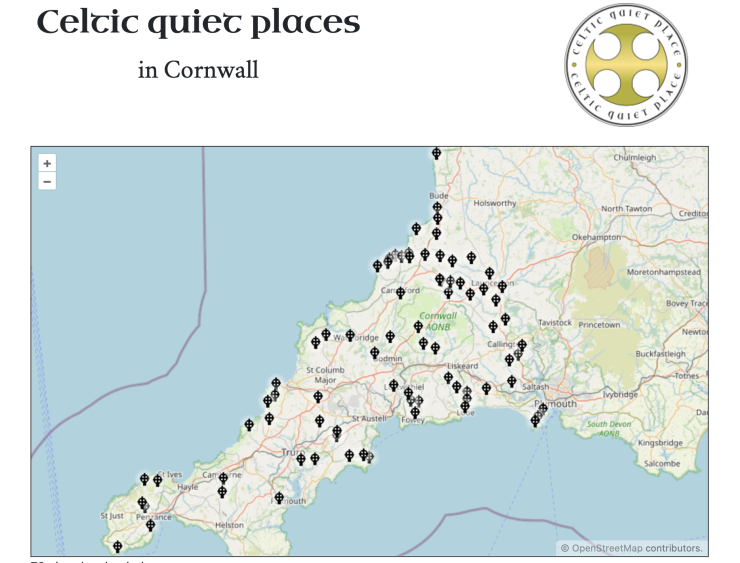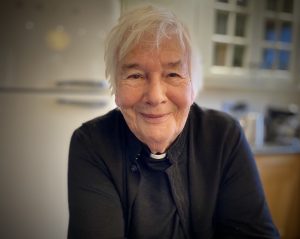New website for Celtic Quiet Places
Celtic Quiet Places in Cornwall haven’t been deliberately hidden from tourists, but they’ve always been one of those off the beaten track ‘if you know, you know’ destinations. But now, a new website will reveal these gentle treasures with anyone looking for peace and quiet reflection.
There are currently 78 Cornish churches designated as a Celtic Quiet Place, each offering a peaceful haven in a world that can seem increasingly chaotic.
The scheme’s website is full of useful and interesting information. As well as opening times, directions and facilities, it reveals the story of each location’s Celtic history. How it came to be named and who the saint was that founded it.
The launch of Celtic Quiet Places fulfils the vision of Revd Canon Pat Robson. “I realised many years ago that despite there being over 300 Cornish Celtic Churches, not to mention the towns and villages named after Celtic saints, Cornwall did little to promote or celebrate its Celtic presence in the world. If you want to have any kind of intentional Celtic experience, you’d have to travel to Lindisfarne or Iona.”
How many know of the county’s rich Celtic heritage?
Visitors pour into Cornwall for the coastline, big skies and surf. But how many know of the county’s rich Celtic heritage? Or its beautiful Celtic Quiet Places nestling in beautiful countryside, waiting patiently to envelope and embrace them? Some of these contemplative sanctuaries have been enriching our lives for the best part of two millennia.
It was a summer encounter that persuaded Revd Pat it was time the secret needed to be shared. “A man walked into the tiny St Just Church in Gorran Haven. He’d left his young family on the beach and was very anxious. He told me he was in debt and couldn’t really afford the holiday. He hadn’t told his wife. I asked if there was anything I could do and he said no, ‘Just let the church hug me.’”
Founded by ancient saints, searching out quiet places to be alone with God, these churches are steeped in love and prayer. Today they long to offer that ‘hug’ to everyone seeking sanctuary.
Making the Celtic Quiet Places happen led Revd Pat to visit almost 80 small churches, hearing or sharing with them their Celtic ancestry. Together they form a network that laces its way across Cornwall. From Morwenstowe to Zennor and St Levan, there will be quiet sanctuary for anyone who needs it.
And for those who like the idea of pilgrimage there will be passports to record each visit, helping to reveal and revive these hidden gems of quiet contemplation.
The Rt Revd Philip Mounstephen, Bishop of Truro, is also thrilled. “I’m so grateful to Pat for all her work on this inspiring project, to make more widely known the enduring power and significance of the holy, special places our Celtic churches are.”
So how did this network of small churches become so woven into the tapestry of Cornish Celtic history? Revd Pat explains, “The Celtic Saints, who were mostly young, were from Romanised Brithonic and Latin speaking Celts who named our nation Britain. Their families were wealthy and influential, but fled West when the Romans left and the Saxons, Angles and Jutes invaded in the 5th Century AD. Suddenly they were refugees in their own country.
Eventually, these British families made new homes either side of Cornwall, in the Welsh valleys and Brittany. Cut off from mainstream Christianity, they were taught by their own Christian teachers who travelled with them, many of whom were inspired by St. Martin of Tours. He advocated abandoning wealth and comfort to seek quiet, deserted places to spend time alone with Christ. After rigorous schooling many of the young Celts left home to become missionaries. They crossed and re-crossed the Cornish peninsular many times and often sought quiet and secluded places where they could rest and pray. This is why many of the Celtic churches in Cornwall are in isolated locations.”
It’s important to understand the impact of St Martin (316-397). A former Roman soldier from Hungary, he famously split his great cloak in half to give warmth to a beggar. In a revelation he saw Jesus as the beggar and set off on a path that changed the way people understood Christianity. Very reluctantly, he became Bishop of Tours, but eschewed its lavish trappings. Sleeping only on a roll-mat he spoke out against the opulence of the church led at the time by Emperor Constantine. A great many young people were drawn to his teachings. They came from all over Europe including Britain, responding to his call to reject the wealth they were born into and seek out God beyond church finery, in the quiet places, in nature, through the people they met. These young people became the teachers ministering to the Celts who fled from the Angles and Saxons, helping them to cope with life as refugees, cut off from all they had known. It was their teaching and that of their pupils that has come to be known to us as Celtic Christianity. And it was these teachers and their pupils who are remembered in the Celtic Quiet Places featured on the website.”
It’s powerful in these times to think of Cornwall as a physical landscape providing relief to refugees
It’s powerful in these times to think of Cornwall as a physical landscape providing relief to refugees. It’s something that Cornwall is so good at doing, from offering shelter to Celts fleeing the marauding Angles and Saxons, to evacuees during World War II, Ukrainians fleeing Putin and even tourists looking for respite from their busy lives.
From the original sites where the Celtic saints settled, villages and towns have developed. Bodmin used to be a forest, and St Austell some woods that became sanctuary to St Austol and his beloved friend St Mewan. St Goran found his original happy place by a spring. But St Petroc, a renowned teacher with a big following visited him and asked if he could share it. Instead, Goran gave him the spring and moved to the coast, close to his childhood friend St Just. It was St Just who inspired the church that provided sanctuary to the tourist of our time.
Even the white cross of the Cornish flag has its origins in the Celtic saints who chose a martyrdom before going out into the world. White martyrdom, symbolised by the white cross, meant leaving families, possibly forever, to become priests and evangelists. Red martyrdom, that bore a red cross on white, was typically chosen by the eldest and heirs. They would become soldiers and protectors. And green martyrdom was the forerunner of environmentalism today, treading lightly on the earth and drawing inspiration from nature.
St Austol was a green martyr who, after making his home in the woods that became St Austell, travelled with St Mewan to Brittany. When Mewan died, Austol was heartbroken and died seven days later. When they opened the tomb to bury him alongside his friend, they found Mewan had moved over to make space for him.
There are a great many stories like this on the Celtic Quiet Places website. As Revd Pat says, “If we don’t share them, we might lose them, like we lost so many of the original church names. When 12th Century Bishop Bronscombe of Exeter pilgrimaged through Cornwall, if the locals couldn’t tell him the story of how a church came to be named, he would change it to a more acceptable saint, like Saint Michael.” Celtic saints had a tough rap from the Pope, they were counter cultural, denigrating the churches wealth and preaching simplicity, so it was no wonder they tried to erase their influence.
Some Cornish secrets are just too precious not to share
Happily, the legacy of the Celtic Saints did endure. It touched the life of a debt burdened father desperate to provide a family holiday, seeking a hug from a quiet church, tucked in a narrow street on the way to the beach. That’s the hope behind Celtic Quiet Places in Cornwall, to make those peaceful spaces available to everyone needing that quiet time away from everything. Some Cornish secrets are just too precious not to share.


